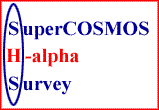
|
|
|
|
|
|
|
|
|
|
|
|
|
|
|
|
|
|
|
|
| |
 | |
| IFA ROE |
Calibrating H-alpha images extracted from the SHS (draft only)
The pixel extraction form Get an Image offers the user access to pixel data from SuperCOSMOS mapping-mode (MM) scans of the narrow-band H-alpha survey images and matching broad-band SR equivalents.The H-alpha data would be much more astrophysically useful if the pixel intensities were calibrated into some meaningful measure of H-alpha flux in Rayleighs or equivalent emission measure.
Unfortunately, at this stage, the SHS on-line survey does not offer pixel images with an associated calibration for determining fluxes of nebulosities.
However, 1-deg field-of-view H-alpha and broad band R CCD mages have been obtained with the Curtis-Schmidt telescope at CTIO for every field in the H-alpha survey and it is the intention that once fully reduced these data may be made generally available. The CCD frames were carefully selected by position in each survey field to contain a representative selection of emission features over a range of intensities and scales. Calibrating PN frames were also observed together with photometric standards.
Issues to consider
Several issues need to be considered when contemplating independent attempts to calibrate the H-alpha data.
Filter band-pass
The H-alpha filter used for the survey has a FWHM of 70A centred at 6590A (a 1% filter). This band
thus encompasses not only the H-alpha line at 6563A but also the adjacent [NII] lines at 6548 & 6584A. These
emission lines vary in strength between different classses of astrophysical object such as PN where the [NII] lines
can sometime dominate.
The width of the filter is also such that there is no velocity discrimination in terms of resolving different components of gasesous emission throughout the galaxy. In fact the filter samples from -300Km/s out to the local Virgo and Fornax clusters around 1100Km/s.
Geocoronal H-alpha emission
This atmospheric component is convolved in with the general H-alpha/[NII] flux incident to the telescope from the
general sky. Although seasonal with temporal and spatial variations we consider the component of Geocoronal
H-alpha to be a `background wash' over the scale sizes of the H-alpha survey fields contributing a constant
background to each exposure but varying between exposures. Note that this may not be a totally safe assumption.
Since the emulsion chemical fog level and sky-brightness also vary for each exposure, adding to the measured
photographic background density on each exposure we considre the component of geocoronal H-alpha in the same vein.
Photographic Saturation
Photographic emulsions usually saturate at a density of around 4. Beyond this, increases in flux incident on the
emulsion do not lead to further increases in measured photographic density. This occurs usually with bright stars
whose cores become saturated but where the growth in size of the overall point spread function is still related to
the stellar magnitdue despite central saturation. For intense emission nebulosities this is not the case due to the
large scale nature of many of these features. It is thus impossible to regain any flux information for such sources
even if a calibration was available. Generally speaking then in such cases a lower limit to the H-alpha flux could
be determined. Interpolation based on surrounding unsaturated regions could also be considered.
Some independent Calibration options available
Recently the CTIO SHASSA H-alpha Survey of the Southern Sky has become available on line. Although
the resolution is considerably poorer than for the AAO/UKST H-alpha survey put on-line as the SHS (40 cf 1
arcsecond) the data has the great virtue of being obtained with CCD image and being calibrated
Direct comparisons can thus be made after blocking down the SHS data to match the same spatial scale.
The SHASSA survey is also more sensitive which should allow a
decent determination of the flux limit of each field in the SHS
On larger scales too the WHAM data (1-deg resolution element) overlaps with some of the more Northen fields of the SHS offering further opportunities for independent calibration assessments.
Home | Intro | Get an Image | Get a Catalogue
Coverage | Documentation | History | Links
WFAU, Institute for Astronomy,
Royal Observatory, Blackford Hill
Edinburgh, EH9 3HJ, UK
M.Read@roe.ac.uk
30/7/2008